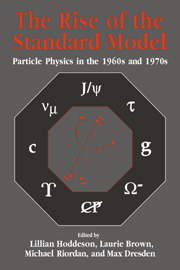Book contents
- Frontmatter
- Contents
- Contributors
- Editors' Acknowledgments
- Photographs of the Symposium
- Abbreviations and Acronyms
- Mathematical Notation
- Part One Introduction
- 1 The Rise of the Standard Model: 1964–1979
- 2 Changing Attitudes and the Standard Model
- 3 Two Previous Standard Models
- Part Two Quarks and Leptons
- Part Three Toward Gauge Theories
- Part Four Accelerators, Detectors, and Laboratories
- Part Five Electroweak Unification
- Part Six The Discovery of Quarks and Gluons
- Part Seven Personal Overviews
- Index
1 - The Rise of the Standard Model: 1964–1979
Published online by Cambridge University Press: 03 February 2010
- Frontmatter
- Contents
- Contributors
- Editors' Acknowledgments
- Photographs of the Symposium
- Abbreviations and Acronyms
- Mathematical Notation
- Part One Introduction
- 1 The Rise of the Standard Model: 1964–1979
- 2 Changing Attitudes and the Standard Model
- 3 Two Previous Standard Models
- Part Two Quarks and Leptons
- Part Three Toward Gauge Theories
- Part Four Accelerators, Detectors, and Laboratories
- Part Five Electroweak Unification
- Part Six The Discovery of Quarks and Gluons
- Part Seven Personal Overviews
- Index
Summary
In the late 1970s elementary particle physicists began speaking of the “Standard Model” as the basic theory of matter. This theory is based on sets of fundamental spin-½ particles called “quarks” and “leptons,” which interact by exchanging generalized quanta, particles of spin 1. The model is referred to as “standard,” because it provides a theory of fundamental constituents – an ontological basis for describing the structure and behavior of all forms of matter (gravitation excepted), including atoms, nuclei, strange particles, and so on. In situations where appropriate mathematical techniques are available, it can be used to make quantitative predictions that are completely in accord with experiment. There are no well-established results in particle physics that clearly disagree with this theory.
This pleasing state of affairs is quite new in particle physics. It contrasts markedly with the theoretical situation in the early 1960s, when there were a variety of different ideas about the subatomic realm. For example, in 1964 most particle physicists considered protons, neutrons, pions, kaons, and a host of other strongly interacting particles (i.e., hadrons) to be in a certain sense “elementary.” By 1979 the consensus had emerged that the hadrons were not elementary after all but are composed of more basic building blocks called quarks, held together by the exchange of another kind of particle called the gluon. Or consider the particle interactions. In 1964 almost all physicists thought the strong, weak, and electromagnetic interactions were independent phenomena, perhaps requiring different types of theories for their description.
- Type
- Chapter
- Information
- The Rise of the Standard ModelA History of Particle Physics from 1964 to 1979, pp. 3 - 35Publisher: Cambridge University PressPrint publication year: 1997
- 5
- Cited by

